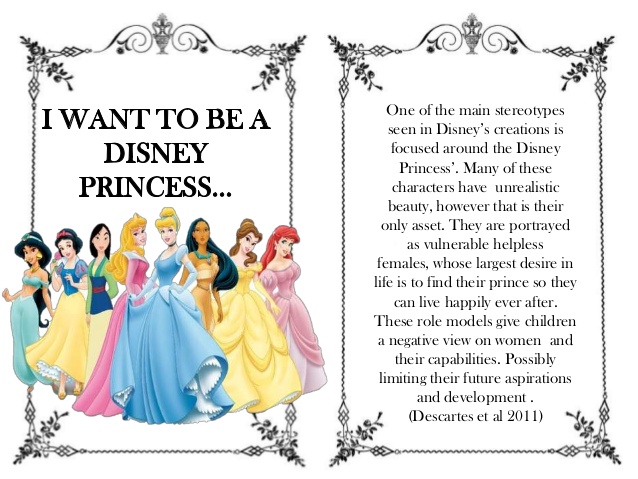It is no secret that the Disney brand is extremely traditional and conservative. Disney Land, Disney movies, and Disney products are “appropriate” for the average American family. Every Disney product ever have knowingly created an gender and race expectations that over time effect the young mind and how they perceive their own race and gender.
My family is primarily made up of girls who all love Disney movies and especially the Disney princesses. When I was younger my favorite one was Princess Jasmine, primarily because she the closest thing I had to black princess at the time. My youngest sister who is 4 years-old is currently obsessed with Princess Ariel because she has long pretty hair and can sing to fishes. When I asked why she doesn’t like the other’s her response was that because they are not as pretty.
Most of the Disney princesses are extremely feminine, young, pretty, thin, and weak. And in most of the plot lines in order for these young women to overcome their challenges or have a “happy ending” they have to be saved, sacrifice a part of themselves, or use their looks. And they can only usually do this through the assistance of a male protagonist. This is the formula that has been used for decades in Disney movies, and it is able to pass by the audience because their audience is primarily children. The promotion of such troupes and characteristics of women are actually quite harmful to their young audience, male and female.
A story by well known Media company Mic. published , “9 Harmful Stereotypes We Never Realized Disney Our Favorite Disney Movie’s Taught Us”. There were all types of stereotypes discussed, but I’m going to focus on the gender ones presented.
- Snow White: Men are hopeless and need women to take care of them.
- Cinderella: Outward beauty is what makes you special.
- Everything pre- Mulan: Being thin and white is what makes women beautiful and valuable.
- Beauty & The Beast, The Little Mermaid, Mulan: Weight determines temperament.
- Pochahantas: Women have to be strong AND gentle.
- All: Men are saviors.
- All: Being masculine mens being hot and buff.
- The Little Mermaid: You should change who you are for your love interest.

The last example is the worst out of them to me personally. The Little Mermaid is not the only example of changing for your love interest, a lot of the Disney’s characters do this. Luckily my mother is wonderful and instills great values in all her children and the reasoning behind my little sister’s love of Ariel has more to do with that she likes to swim more than her physical appearance.
The hyper sexualization of female characters and the hyper masculinity of male characters effects most other viewers though, and it can mold their thoughts and perspectives for the rest of their lives if not pointed out and understood. Whether these messages are intentional or unintentional is a whole other argument but Disney is somewhat improving, and realizing the danger behind their messages. Movies like Lilo & Stitch, and Princess & The Frog, Mulan, and Frozen show more diversity and changing traditional gender and racial roles.
Cover Image Credit: Mic.com
There were far too many problems within The Princess and the Frog, that the diversity of the movie is completely overshadowed by those problems. I’m very surprised that the author failed to mention the gender stereotypes, gender misrepresentation, and blatant racism that was in P&F. But this article just proves that you’re satisfied, so long as you see a “diverse” face.
LikeLike
I as a black woman of course saw the mis-representation of that film but that wasn’t the purpose of this particular story. That is a whole other article it self but thank you for your feedback.
LikeLike